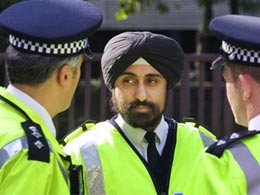
Washington, May 17: Sikh police officers in the American capital will be allowed to wear turbans, beards and other religious items while on the job.
The new uniform policy announced by Washington DC police Chief Cathy Lanier Wednesday makes it the first major metropolitan police department in the US to permit Sikhs to maintain their articles of faith.
Developed with the Sikh American Legal Defence and Education Fund (SALDEF), the new police policy states that Sikh officers can wear turbans that are the same colour as the uniform that they would otherwise be required to wear, with the department badge that is normally on hats pinned to the front of the turban.
Male Sikh officers will also be able to wear beards that are neatly kept. Other officers are allowed to grow beards if they get a waiver from the department.
Lanier said that it is hard to find qualified police officers, so it is practical to accommodate candidates who would otherwise be fit for the job. "This is a common-sense decision," she said.
There are no known observant Sikhs among Washington's roughly 3,800 officers. However, the new policy was motivated in part because a Sikh who will graduate from the police academy in August and plans to become a reserve officer, has requested the accommodation, Lanier said.
"This first of a kind guidance by one of the nation's premier law enforcement agencies serves as a model for other agencies across the country." said Jasjit Singh, Executive Director of SALDEF.
In other parts of the country, Sikhs have had to fight for religious accommodations, he said, noting that nine years ago members of the Sikh community sued New York City to become traffic enforcement officers.
In the Los Angeles County Sheriff's Department, observant Sikhs can serve in the reserves but not as full-time officers.
There are about 700,000 adherents to the Sikh faith in the US, according to SALDEF.





Comments
Add new comment